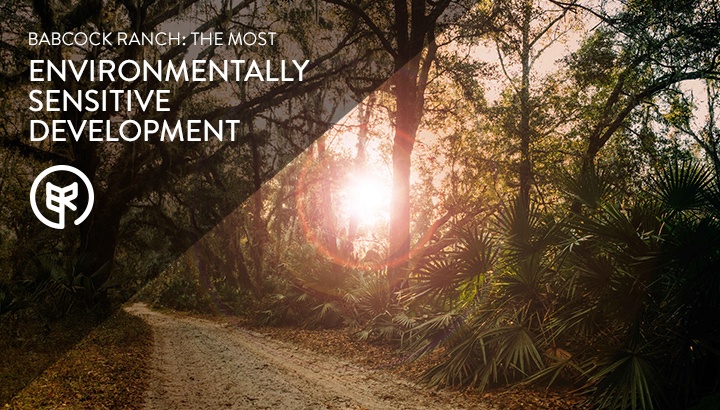Curry Lake is a prime example why Babcock Ranch has been hailed as the most environmentally sensitive development in Florida.
The lake on the Babcock Ranch property provides a model for the surface-water management strategies that will be incorporated throughout the town as it grows. Rather than create manmade solutions for storm water, Babcock Ranch restored the capacity of natural systems to slow and filter surface waters as they make their way across the property.
Here’s how: Kitson & Partners, the developer of Babcock Ranch, built three weirs in 2012 to rehydrate about 70 acres near Curry Lake to historic conditions. The natural surface water flows had been significantly altered over the years by farming and ranching, so Kitson built these low dams to regulate water flow.
With the weirs now retaining water that was previously drained off through the ranch’s system of ditches, the wet season has been significantly extended, starting a month earlier and ending a month later.
Almost immediately, native vegetation began reclaiming the territory. By restoring the area to natural conditions, native plants reclaimed their advantage over the invasive plants that had benefited from drier soil. Below the surface, crayfish have returned, a prime attraction for a host of birds that once again congregate along the banks.
 Wildlife corridors
Wildlife corridors
Because of Babcock Ranch’s size, Kitson worked with environmental groups to create a regional wildlife connectivity study. The purpose of the study is to create permanent wildlife corridors connecting parks and natural lands throughout southwest Florida with Babcock Ranch.
Babcock Ranch covers 91,360 acres in Charlotte and Lee counties and it includes 73,239 acres that was purchased by the state’s Florida Forever program, the largest acquisition in the program’s history.
The conservation area, named Babcock Ranch Preserve, has tremendous ecological value because it includes many imperiled and declining species and it is strategically located to protect wildlife corridors.
According to the study, what conservation biologists are interested in is not corridors per se, but rather functional connectivity, which involves the flow of individuals and their genes among habitats and populations. Besides their value in providing dwelling and breeding habitat for some species, corridors potentially facilitate movement of animals within home ranges, seasonal migrations or wanderings of animals and dispersal of juveniles or adults of animal or plant species. These in turn provides for colonization or recolonization of suitable habitat patches and for movement of individuals among populations over a larger area, the study says.
and populations. Besides their value in providing dwelling and breeding habitat for some species, corridors potentially facilitate movement of animals within home ranges, seasonal migrations or wanderings of animals and dispersal of juveniles or adults of animal or plant species. These in turn provides for colonization or recolonization of suitable habitat patches and for movement of individuals among populations over a larger area, the study says.
A regional resource
Located within the Caloosahatchee River Basin, the Babcock Ranch Preserve anchors a conservation corridor of public and private land that stretches from Lake Okeechobee to the Gulf of Mexico. The preserve spans a diverse mosaic of pinelands, including both wet and mesic pine flatwoods, and dry prairie ecosystems interspersed with cypress domes and cypress swamps, according to the Florida Fish and Wildlife Conservation Commission.
 A dominant feature on the landscape is Telegraph Swamp, a cypress strand swamp located in the eastern half of the property and runs north to south. The preserve’s wetlands contribute to aquifer recharge for Southwest Florida and help maintain the health of the western Everglades ecosystem, particularly the Caloosahatchee River and Charlotte Harbor estuary.
A dominant feature on the landscape is Telegraph Swamp, a cypress strand swamp located in the eastern half of the property and runs north to south. The preserve’s wetlands contribute to aquifer recharge for Southwest Florida and help maintain the health of the western Everglades ecosystem, particularly the Caloosahatchee River and Charlotte Harbor estuary.
Together with nearby conservation lands, including the Babcock-Webb Wildlife Management Area, the Bob Janes Preserve and the Caloosahatchee Regional Park, the Preserve provides habitat for wide-ranging species such as the Florida black bear and Florida panther and is home to the Osceola subspecies of native wild turkey, which is found only in peninsular Florida.
In addition to abundant populations of white-tailed deer, wild turkey, and northern bobwhite, there are 13 wildlife species that are listed as endangered, threatened or of special concern. The list includes crested caracara, gopher tortoise, red-cockaded woodpecker, eastern indigo snake, Florida burrowing owl, Florida panther and Florida black bear. You can read more about this here.
To learn more about Babcock Ranch and the wildlife you’ll see there, call us to schedule a visit at 877-484-4434.





